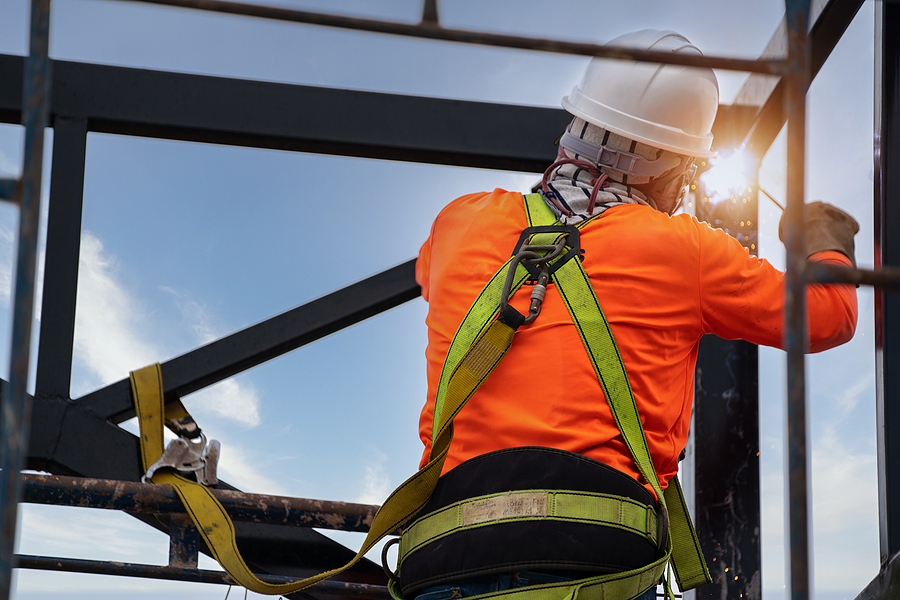New Mexico Construction Site Fall Prevention and Fall Protection Spelled Out

Falls remain the primary cause of mortality on New Mexico construction sites, even though construction workers are exposed to various possible work hazards. According to research conducted by OSHA in 2018, deaths caused by falls accounted for nearly one-third of all deaths that occurred on construction sites.
It should come as no surprise that fall prevention is at the top of OSHA’s list of the most severe infractions year after year. Considering the potential difficulty of preventing and protecting construction workers from falls, this should not be surprising.
To aid in discovering strategies to minimize falls on site and increase worker safety, this article will go over some of the most significant components of OSHA Standard 1926 Subpart M: Fall Protection.
Definitions of Fall Protection and Fall Prevention for the Construction Industry
A fall prevention system either eliminates the risk of construction workers falling or prevents them from falling in the first place. On the other hand, the term “fall protection” often refers to all the controls and processes utilized to reduce the impact and severity of a coming fall if it does occur.
Controls for preventing falls include physical barriers, such as barricades and guard rails, and procedural rules, such as fall prevention planning and training for construction workers. Equipment controls include, for example, scaffolding.
Personal protective equipment (PPE) that complies with OSHA regulations should be used for fall protection. Examples of PPE include hard helmets, harnesses, and lanyards. The OSHA standard for fall protection mandates, as a matter of course, that construction workers receive the appropriate training to use and use personal protective equipment (PPE).
The Occupational Safety and Health Administration (OSHA) has regulations for the use of fall protection and encourages examining fall prevention strategies and risk reduction wherever practicable.
The Vector EHS Management Software gives businesses of all sizes, from multinational corporations to one-person shops, the ability to comply with environmental, health, and safety standards while enhancing worker safety.
Please find out more about how utilizing our software may help you save significant time and effort in documenting, tracking, and evaluating the activities related to EHS.
At What Height is Fall Protection Required?
The following are examples of situations in which OSHA mandates the use of fall protective gear for workers:
- Whenever a person is operating near exposed sides or edges more than six feet above the ground.
- When personnel working at excavation sites need them to be six feet below the surface, they must wear fall protection or fall arrest equipment to prevent themselves from falling to their deaths.
- Workers involved in operations on the roof are required to work at the height of six feet above the ground.
Take These Straightforward Measures to Protect Yourself and Prevent Falls in Construction.
The following easy actions, which safety specialists on the job site may follow, will help prevent falls from occurring:
Develop a Construction Fall Protection Plan
Each construction job site requires its individualized fall prevention strategy, which evaluates the potential risks of falls connected with each construction operation at the job site. On its website, OSHA provides a template for a fall protection plan in the construction industry and suggests that a plan contain components such as:
- Company policy
- A detailed explanation of the fall safety devices that will be utilized on the building site.
- The implementation of the strategy for fall protection
- Traditional fall protection methods are being explored, in addition to new potential fall protection techniques.
A comprehensive strategy for job safety analysis is something that many companies routinely include in fall protection planning. Check out the post we made on our blog for more information on the four phases of a job safety analysis.
Conduct Daily Walk-throughs
Before beginning work for the day, supervisors, employees, or safety professionals at many construction sites conduct a daily walk-through to identify and address any fall hazards. This is integral to the best construction practices developed over the years. A job safety analysis template is utilized on specific job sites, and individual personnel must sign off indicating that all relevant job risks have been identified and mitigated before commencing work. This is done before work may begin.
Components that a site safety supervisor might investigate include:
- Placement of ladders, scaffolding, and safety rails, as well as their current states
- An evaluation of any new fall risks that may have been introduced on the site.
- An inspection of the Personal Fall Arrest Systems (PFASs) worn by workers, also known as fall restraints
- A review of all employee and safety contractor badges and cards to ensure that each employee and contractor has obtained the necessary safety training.
Before being used, fall safety equipment must be subjected to a daily check by employees and contractors.
Inspect Fall Protection Equipment
Regular fall protection equipment inspections should be carried out in accordance with OSHA regulations and the recommendations of the relevant manufacturer. Following OSHA regulation 1926.502(d) 21, personal fall arrest systems must undergo a pre-use inspection to check for signs of wear, damage, and other types of degradation. Defective components are then needed to be removed from use.
A review of the following components should be included in an examination of fall prevention equipment:
- The process of stitching and webbing
- Broken strands
- Hooks, D-wings, and a variety of additional components
Most manufacturers of different types of equipment mandate that their products undergo a qualified examination once every six months.
Fall Prevention and Fall Protection Training Courses and Toolbox Talks
Because fall protection and prevention are so critical to the overall health and safety of construction workers, OSHA advises including recommendations on preventing falls in construction, often in toolbox talks and construction safety meetings with employees.
In addition, OSHA mandates that workers get training in the correct application of fall protective equipment and the prevention of falls. The following are examples of common fall protection concerns for front-line construction workers:
- Protection against Falls in Working Environments of Construction
- Construction Environments Can Be Dangerous Due to Slips, Trips, and Falls
- safety of supported scaffolding in the context of the construction environment
- Safety Concerns Regarding Suspended Scaffolding in Construction Environments
Employees should also get thorough training in working at heights, such as using ladders and aerial lifts, among other relevant issues.
